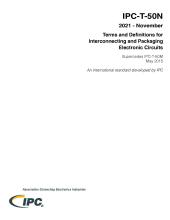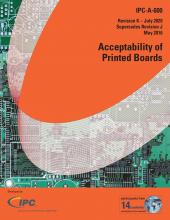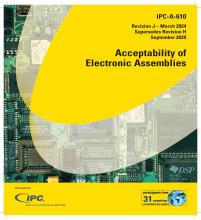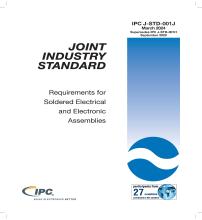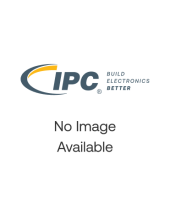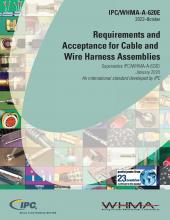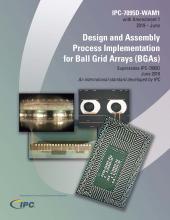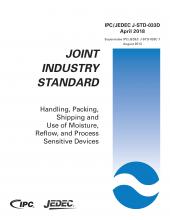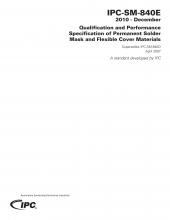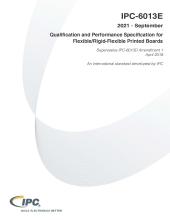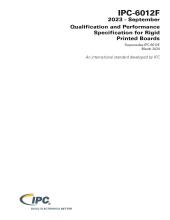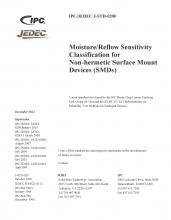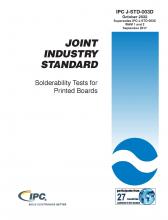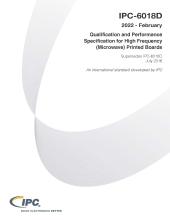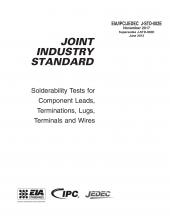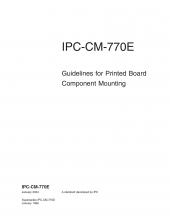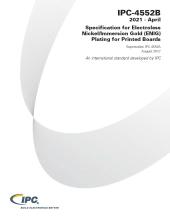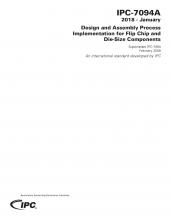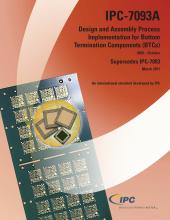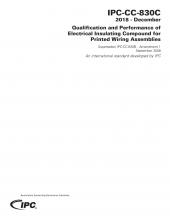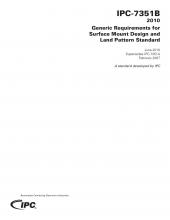IPC-T-50N document is designed to provide definitions for terms commonly used in the electronics industry. The definitions are intended to provide sufficient clarity of detail such that a reader utilizing English as a second language could understand the subtleties of the meaning. IPC-T-50N contains over 550 new or revised terms, including new terminology for via structures, surface mount device...
The definitive illustrated guide to printed board acceptability! This four-color document provides photographs and illustrations of the target, acceptable and nonconforming conditions that are either internally or externally observable on bare printed boards. Make sure your operators, inspectors, and engineers have the most current industry consensus information. With 120 new or revised...
IPC-A-610J is the most widely used electronics assembly acceptance standard in the electronics industry. Participants from 31 countries provided their input and expertise to bring this document to the electronics industry. IPC-A-610J is a must-have standard for inspectors, operators and others with an interest in the acceptance criteria for electronic assemblies. IPC-A-610 is developed in synergy...
IPC J-STD-001J is recognized globally for its criteria on soldering processes and materials. Updated with participants from 27 countries providing input and expertise. IPC J-STD-001J is a must-have for those in the electronics industry with an interest in the process and acceptance criteria for electrical and electronic assemblies. IPC J-STD-001 is developed in synergy with IPC-A-610 and is...
The IPC-7711/21 guide provides procedures for rework, repair and modification of printed board assemblies, including tools and materials, common procedures, coating removal and graphics to assist the user.
IPC/WHMA-A-620E is the only industry-consensus standard for Requirements and Acceptance of Cable and Wire Harness Assemblies. IPC/WHMA-A-620E describes materials, methods, tests and acceptance criteria for producing crimped, mechanically secured and soldered interconnections and the related assembly activities associated with cable and harness assemblies. IPC/WHMA-A-620E was developed by IPC and...
The IPC-7095D-AM1 standard describes design and assembly implementation for ball grid array (BGA) and fine-pitch BGA (FBGA) technology, focusing on inspection, repair and reliability issues associated with design and assembly of printed boards using these packages. IPC-7095D-AM1 provides the useful and practical information to those who use or are considering using BGAs. IPC-7095D-AM1 provides...
IPC/JEDEC J-STD-033D provides surface mount device manufacturers and users with standardized methods for handling, packing, shipping and use of moisture/reflow sensitive components. These methods help avoid damage from moisture absorption and exposure to solder reflow temperatures that can result in yield and reliability degradation and damaged components. IPC/JEDEC J-STD-033D procedures provide a...
Establishes the requirements for the evaluation of liquid and dry film solder mask material and for the determination of the acceptability of use on a standard printed board system. IPC-SM-840 provides two classes of requirements, T and H, to reflect functional performance requirements and testing severity based on industry/end use requirements. Coverage is given to adhesion, material qualification...
IPC-6013E standard covers qualification and performance requirements for flexible printed boards designed to IPC-2221 and IPC-2223. The flexible printed board may be single-sided, double-sided, multilayer or rigid-flex multilayer. All of these constructions may include stiffeners, PTHs, microvias, and blind/buried vias. The IPC-6013E standard incorporates new and updated requirements for final...
IPC-6012F, covers qualification and performance of rigid printed boards, including single-sided, double-sided, with or without plated-through holes, multilayer with or without blind/buried vias and metal core boards. It addresses final finish and surface plating coating requirements, conductors, holes/vias, frequency of acceptance testing and quality conformance as well as electrical, mechanical...
IPC-4101E-WAM1 covers the requirements for base materials that are referred to as laminate or prepreg and listed in the specification sheets which are found after the main body of the standard. The specification sheets are to be used primarily for rigid and multilayer printed boards for electronic interconnections. The IPC-4101E-WAM1 standard contains 70 individual specification sheets that can be...
IPC-2223E used in conjunction with IPC-2221, IPC-2223 establishes the specific requirements for the design of flexible printed boards and forms of component mounting and interconnecting structures. The flexible materials used in the structures are comprised of insulating films, reinforced and/or non-reinforced dielectric in combination with metallic materials. IPC-2223E provides new design...
IPC-1791D standard provides minimum requirements, policies and procedures for printed board design, fabrication, assembly, and cable and wire harness assembly organizations and/or companies to become trusted sources for markets requiring high levels of confidence in the integrity of delivered products. These trusted sources shall ensure quality, supply chain risk management (SCRM), security and...
IPC/JEDEC J-STD-020F standard is to identify the classification level of nonhermetic SMDs designed for surface mount assembly that are sensitive to moisture-induced stress so that they can be properly packaged, stored, and handled to avoid damage during assembly solder reflow attachment and/or repair operations. IPC/JEDEC J-STD-020F standard may be used to determine what classification level...
The IPC J-STD-003D standard describes solderability determinations that are made to verify that the printed board fabrication processes and subsequent storage have had no adverse effect on the solderability of those portions of the printed board intended to be soldered. Solderability is determined by evaluation of a test specimen which has been processed as part of a panel of boards and...
The IPC-6018D standard covers qualification and performance of high frequency (microwave) boards, including single-sided, double-sided, with or without plated-through holes, multilayer with or without blind/buried vias and metal core boards. It addresses final finish and surface plating coating requirements, conductors, holes/vias, frequency of acceptance testing and quality conformance as well as...
IPC-J-STD-002E prescribes test methods, defect definitions, acceptance criteria, and illustrations for assessing the solderability of electronic component leads, terminations, solid wires, stranded wires, lugs, and tabs. The IPC-J-STD-002E standard also includes a test method for the resistance to dissolution/dewetting of metallization. IPC-J-STD-002E is intended for use by both supplier and user...
This revision provides effective guidelines in the preparation and attachment of components for printed circuit board assembly and reviews pertinent design criteria, impacts and issues. It contains techniques for assembly (both manual and machines including SMT, BGA and flip chip) and consideration of, and impact upon, subsequent soldering, cleaning, and coating processes. 150 pages. Revised...
This document bears two reference numbers, and may be obtained from IPC or the IEC. IPC-D-350D and IEC 1182-1 are identical in technical content. The IEC version of this document also contains a French translation. The IEC is responsible for the accuracy of that translation. Specifies record formats used to describe printed board products with detail sufficient for tooling, manufacturing and...
IPC-4552B standard sets the requirements for Electroless Nickel / Immersion Gold (ENIG) deposit thickness for applications including soldering, wire bonding, and as a contact finish. IPC-4552B standard is used to specify acceptance criteria to meet performance standards for IPC-6010 family of documents including IPC-6012, IPC-6013 and IPC-6018. The ENIG deposit specified using this document will...
IPC-7094A describes the design and assembly challenges for implementing flip chip technology in a direct chip attach (DCA) assembly. The effect of bare-die or die-size components in a flip chip format has an impact on component characteristics and dictates the appropriate assembly methodology. The IPC-7094A standard focuses on design, assembly methodology, critical inspection, repair and...
The IPC-7093A standard provides essential design and assembly guidance for implementing bottom termination components (BTCs). Specifically, IPC-7093A provides guidelines on critical design, materials, assembly, inspection, repair, quality, and reliability issues associated with BTCs.
The IPC-CC-830C standard establishes qualification and conformance requirements for electrical insulating compounds (conformal coatings). It has been designed and constructed with the intent of obtaining maximum confidence in the materials with minimum test redundancy. The IPC-CC-830C standard covers: • The qualification and qualification retention of the conformal coating material (Table 3-1...
This popular document covers land pattern design for all types of passive and active components, including resistors, capacitors, MELFs, SOPs, QFPs, BGAs, QFNs and SONs. The standard provides printed board designers with an intelligent land pattern naming convention, zero component rotations for CAD systems and three separate land pattern geometries for each component that allow the user to select...

